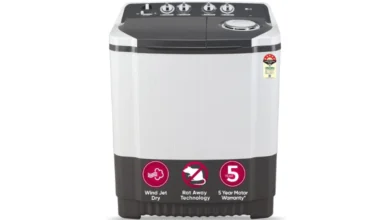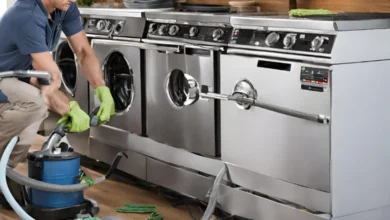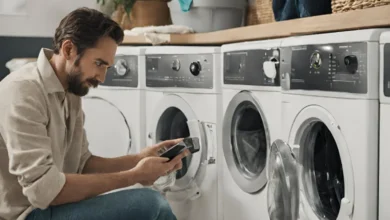Front-Load vs Top-Load Washing Machines – Which One is Better?

Washing machines have come a long way from the traditional washboard and basin. Finding best washing machine in India 2024 is difficult as so many options are available and people get confused. In today’s technologically advanced world, two popular types of washing machines dominate the market – front-load and top-load. Each type has its own set of features, advantages, and disadvantages. In this blog, we will decode the technology behind front-load and top-load washing machines to help you make an informed decision when choosing the right appliance for your laundry needs.
Design and Loading Mechanism:
Front-Load: Front-load washing machines are characterized by their horizontal drum orientation, allowing clothes to be loaded from the front. This design is not only aesthetically pleasing but also provides efficiency in water usage and detergent distribution.
Top-Load: On the other hand, top-load washing machines have a vertical drum, and clothes are loaded from the top. This design is more traditional and often preferred by those who find it more convenient to load and unload laundry without bending over.
Cleaning Performance:
Front-Load: Front-load machines are renowned for their superior cleaning performance. The drum rotates horizontally, allowing gravity to assist in pulling dirt and detergent residue away from the clothes. Additionally, front-loaders typically use less water, making them more energy-efficient.
Top-Load: While top-loaders have improved in terms of cleaning performance over the years, some argue that they might not be as effective as front-loaders, especially when dealing with heavily soiled clothes. However, advancements in technology, such as high-efficiency top-loaders, have narrowed the performance gap.
Energy Efficiency:
Front-Load: Front-load washing machines are generally more energy-efficient than their top-load counterparts. The horizontal drum design requires less water, and these machines often have faster spin speeds, resulting in clothes that require less time in the dryer.
Top-Load: Traditional top-loaders can be less energy-efficient due to their design and water usage. However, high-efficiency top-loaders, equipped with advanced features, aim to bridge this gap and offer better energy performance.
Space and Installation
Front-Load: Front-load washing machines are stackable, making them suitable for compact spaces like closets or laundry rooms with limited square footage. This stackable design allows for a dryer to be placed on top, optimizing vertical space.
Top-Load: Top-loaders are generally easier to access, especially for those who may have difficulty bending over. Additionally, they don’t require bending down to load and unload, making them more accessible for people with mobility issues.
Cost Considerations:
Front-Load: Front-load washing machines often come with a higher upfront cost compared to top-loaders. However, the long-term savings in water and energy bills may offset the initial investment.
Top-Load: Traditional top-loaders are usually more budget-friendly, making them a popular choice for those looking for an economical washing machine. However, high-efficiency top-loaders may have a higher upfront cost but offer better long-term savings.
Conclusion:
In the end, the choice between a front-load and top-load washing machine depends on your preferences, lifestyle, and budget. Consider factors like cleaning performance, energy efficiency, space constraints, and cost when making your decision. With advancements in technology, both types of washing machines have become increasingly efficient, offering consumers a range of options to suit their specific needs. So, whether you opt for the sleek design of a front-load machine or the convenience of a top-load machine, rest assured that today’s washing machines are designed to make your laundry routine more efficient and effective.
What is the Average Lifespan of a Washing Machine?
In the realm of household appliances, the lifespan of a washing machine is a subject rich with nuances and variables that demand meticulous examination. As an authority in the field, it is imperative to delve into the intricacies that influence the endurance of these indispensable devices. This exploration encompasses the typical lifespan, multifarious factors shaping it, invaluable maintenance insights, and a discerning look into the evolving landscape of washing machine technology.
Average Lifespan of a Washing Machine:
The oft-cited average lifespan of a washing machine, a benchmark frequently proffered in the range of 10 to 14 years, serves as a starting point for our expert analysis. Nevertheless, this figure serves merely as a broad stroke, susceptible to variations contingent on a plethora of dynamic factors.
- Usage Frequency: At the forefront of these considerations is the frequency of usage, an aspect where intricacies abound. The relentless demands imposed by a larger household, with the washing machine tirelessly engaged, can potentially curtail its lifespan when juxtaposed with a more sparingly used counterpart in a smaller dwelling.
- Maintenance: A pivotal determinant lies in the conscientiousness of maintenance practices. Routine inspections, meticulous cleaning of lint filters, and a judicious eye for loose components collectively contribute to the resilience of the washing machine. The axiom holds true: neglecting these seemingly mundane tasks can precipitate premature wear and eventual breakdown.
- Quality of the Machine: Notably, the provenance and pedigree of the machine itself play a cardinal role. Opting for a higher echelon of quality, often manifested in well-known and reputable brands, may prove to be an investment in durability. This discernment is pivotal in navigating the labyrinth of choices available to the discerning consumer.
Factors Affecting Lifespan:
- Technological Advances: The inexorable march of technological progress introduces a dichotomy. On one hand, modern washing machines tout innovative features and advanced materials that ostensibly fortify their durability. Yet, on the other hand, the escalating complexity may render them susceptible to an increased incidence of potential points of failure.
- Water Quality: A factor often relegated to the periphery but wielding substantial influence is the quality of water in a given locale. The scourge of hard water, laden with minerals, precipitates deposits and encrustations within the machine, potentially paving the way for malfunctions.
- Environmental Conditions: The ambient conditions in which the washing machine operates should not be overlooked. The caprices of extreme temperatures, humidity, or the presence of contaminants can clandestinely conspire to expedite wear and tear. Strategic placement in a controlled environment emerges as a subtle yet influential variable.
Maintenance Tips for Longevity:
- Regular Cleaning: Vigilance in regular cleaning rituals emerges as a linchpin in the preservation of a washing machine’s vitality. From the meticulous cleaning of lint filters after each use to periodic cleansing cycles with specialized washing machine cleaners, these practices constitute a proactively defensive posture against the encroachment of detrimental residues.
- Leveling the Machine: The seemingly mundane task of ensuring the machine is impeccably leveled takes on an elevated significance. An unbalanced machine, rattling with exuberance during the spin cycle, can incur premature wear on its internal components, a predicament readily mitigated through the simple yet vital act of leveling.
- Inspect Hoses and Connections: The sagacious homeowner directs their gaze to hoses and connections, performing periodic inspections for signs of wear or insidious leaks. The proactive replacement of worn components and the assurance of taut connections serve as a bulwark against potential water-induced calamities.
- Load Balance: A judicious approach to loading the machine is indispensable. Overburdening the washing machine, a common proclivity, exacts a toll on its motor and associated components, potentially truncating its operational lifespan. Practicing restraint in load management emerges as an investment in longevity.
- Mindful Detergent Use: Precision in detergent dispensation transcends the realm of mere hygiene. Overindulgence in detergent deployment can foster insidious residues within the machine, surreptitiously undermining its efficacy. Adhering to recommended detergent quantities is tantamount to nurturing the machine’s operational vitality.
Evolving Landscape of Washing Machine Technology:
The landscape of washing machine technology, a canvas ever evolving, offers a glimpse into the trajectory of advancements that shape the contemporary market.
- Smart Technology: The entwining of washing machines with smart technology beckons a new era. Remote control and monitoring capabilities, though endearing, usher in a new layer of complexity. The astute consumer, while embracing the conveniences afforded, remains vigilant to the potential vulnerabilities intrinsic to these electronic augmentations.
- Energy Efficiency: A conspicuous trend in modern washing machines revolves around the paradigm of energy efficiency. The zeitgeist of sustainability propels the integration of machines that judiciously consume water and electricity, thereby reducing operational costs and treading lightly upon the environmental stage.
- Material Advances: The crucible of innovation extends to material sciences, where stainless steel drums and corrosion-resistant components emerge as sentinels against the ravages of time. These material advances, when judiciously employed, contribute to a robust and enduring washing machine architecture.
- Innovative Features: The relentless pursuit of excellence introduces a panoply of features, ranging from steam-cleaning prowess to automatic detergent dispensers. While these innovations augment cleaning efficacy, the discerning consumer maintains a measured skepticism, cognizant of potential complexities and the attendant points of failure.
Conclusion:
In summation, the average lifespan of a washing machine, while perched within the 10 to 14-year spectrum, is a nuanced metric subject to the orchestration of myriad variables. As a custodian of expert insights, the imperative of regular maintenance practices and an astute awareness of usage patterns cannot be overstated.
The landscape of washing machine technology, akin to a tapestry unfurling, beckons with promises of efficiency and sustainability. Striking a delicate balance between embracing innovation and safeguarding the machine’s longevity emerges as the modus operandi for the savvy consumer. In the hands of a discerning user, a washing machine transcends the banality of a domestic artifact, evolving into a stalwart companion capable of enduring the rigors of the laundry domain with finesse and resilience.






